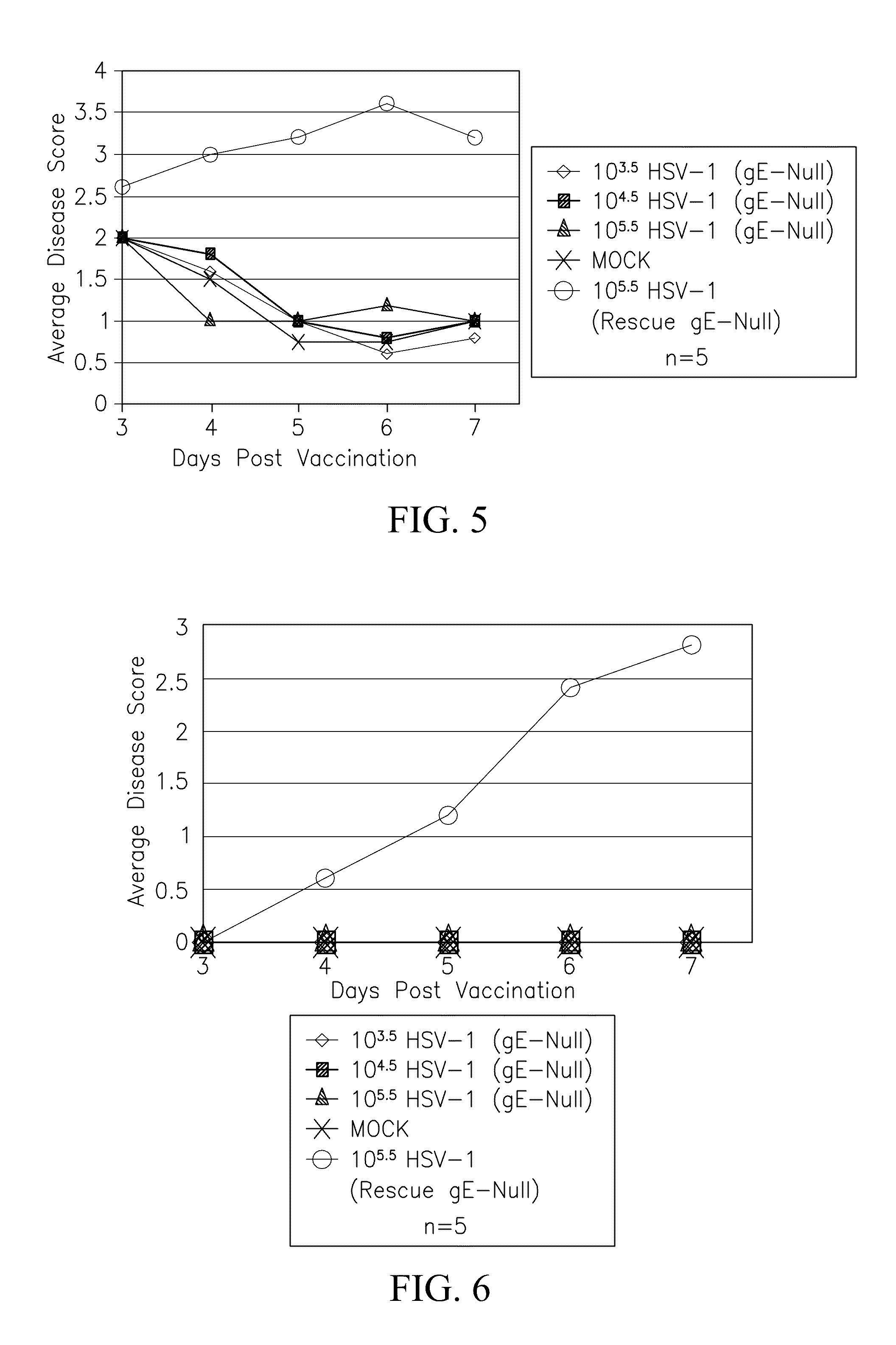Methods of use for hsv-1 and hsv-2 vaccines
a technology of hsv-1 and hsv-2, which is applied in the field of methods of use for hsv1 and hsv2 vaccines, can solve the problems of two-fold increase in the hiv transmission rate, particularly in the case of newborn infants and immunosuppressed individuals, and achieve the effects of reducing pathogenesis, prolonging latency, and improving symptoms
- Summary
- Abstract
- Description
- Claims
- Application Information
AI Technical Summary
Benefits of technology
Problems solved by technology
Method used
Image
Examples
example 1
HSV(gE NULL) does not Cause Disease Materials and Experimental Methods (Examples 1-4)
Virus Strains
[0268]Wild-type HSV-1 strain NS, a low-passage-number clinical isolate, was used for generation of mutant viruses. To construct HSV-1(gE null), the entire gE coding sequence was excised from pCMV3gE-1 with XbaI and cloned into pSPT18. pSPT18 has the sequence:
(SEQ ID No: 1)gaatacaagcttgcatgcctgcaggtcgactctagaggatccccgggtaccgagctcgaattccggtctccctatagtgagtcgtattaatttcgataagccagctgggcctcgcgcgtttcggtgatgacggtgaaaacctctgacacatgcagctcccggagacggtcacagcttgtctgtaagcggatgccgggagcagacaagcccgtcagggcgcgtcagcgggtgttggcgggtgtcggggcgcagccatgacccagtcacgtagcgatagcggagtgtatatactggcttaactatgcggcatcagagcagattgtactgagagtgcaccatatgcggtgtgaaataccgcacagatgcgtaaggagaaaataccgcatcaggcgctcttccgcttcctcgctcactgactcgctgcgctcggtcgttcggctgcggcgagcggtatcagctcactcaaaggcggtaatacggttatccacagaatcaggggataacgcaggaaagaacatgtgagcaaaaggccagcaaaaggccaggaaccgtaaaaaggccgcgttgctggcgtttttccataggctccgcccccctgacgagcatcacaaaaatcgacgctcaag...
example 2
HSV(gE NULL) does not Spread within Sensory Neurons
[0280]HSV-1(Rescue gE null) infection caused severe secondary (zosteriform) ulcerative and necrotic lesions that first appeared at 4-5 (days post-infection) dpi (FIG. 6). In contrast, no secondary lesions were seen following HSV-1(gE null) infection. Since secondary lesion formation along the dermatome depends on the ability of the virus to spread along neurons from the skin to the ganglia, and then back again, these results show that the vaccine is not able to spread within sensory neurons. Therefore, HSV(gE null) is unable to cause recurrent infection.
example 3
HSV(gE NULL) Replicates within Skin Cells
[0281]To determine the extent of replication of HSV-1(gE null) in skin cells, mice (n=3) were infected with HSV-1(gE null) or virulent HSV-1(Rescue gE null). On days 1, 3, 6, 8 and 13 post-inoculation, mice were sacrificed, skin at the site of inoculation was removed, and DRG from the right side of each mouse were pooled. Titering to determine viral content of the homogenized tissue revealed that HSV-1(gE null) replicated in skin following vaccination, but less extensively than HSV-1(Rescue gE-null) (FIG. 7). Further, HSV-1(gE null)-vaccinated skin was infiltrated by immune cells, and the virus was cleared by day 6 (FIG. 8).
[0282]These results show that HSV(gE null) replicates in the skin, and thus is expected to elicit an inflammatory response by the host.
[0283]Levels of HSV-1(Rescue gE null) exceeded that of HSV-1(gE null) by 4 orders of magnitude (FIG. 9). In addition, no infectious virus was detected in DRG of mice infected with HSV-1(gE ...
PUM
| Property | Measurement | Unit |
|---|---|---|
| pH | aaaaa | aaaaa |
| time | aaaaa | aaaaa |
| pH | aaaaa | aaaaa |
Abstract
Description
Claims
Application Information
 Login to View More
Login to View More - R&D
- Intellectual Property
- Life Sciences
- Materials
- Tech Scout
- Unparalleled Data Quality
- Higher Quality Content
- 60% Fewer Hallucinations
Browse by: Latest US Patents, China's latest patents, Technical Efficacy Thesaurus, Application Domain, Technology Topic, Popular Technical Reports.
© 2025 PatSnap. All rights reserved.Legal|Privacy policy|Modern Slavery Act Transparency Statement|Sitemap|About US| Contact US: help@patsnap.com



